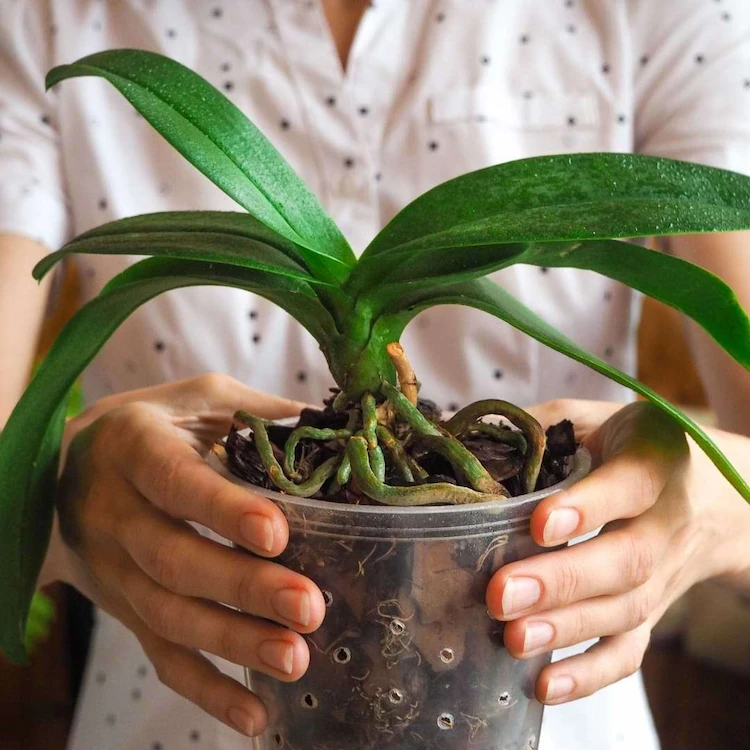Typically, orchids shed leaves as they produce new growth. However, it can happen that the leaf loss is due to some problem with the plant. Your orchid will lose leaves if not cared for properly or if it is attacked by diseases. Read on to learn what to do and how to fix orchid leaf fall.
Natural causes of leaf loss
Orchids can lose their leaves because that is the natural way of things. There are deciduous orchids, like some species of Dendrobium orchid, that shed their leaves seasonally. You can’t do anything about it. Consider that all orchids will naturally shed their oldest leaves before they flower. Therefore, you shouldn’t worry.
Orchid loses leaves due to lack of nutrients
Due to a lack of nutrients, the leaves of the orchid may turn yellow and fall off. Orchids need to be fertilized regularly, otherwise the plant will become unhealthy. How often to fertilize orchids? As a rule, orchids should be fertilized every 1-2 weeks during the growth and flowering period. In the dormant phase you should fertilize your plants every 3-4 weeks.
Watch out for root rot

Root rot is a common problem with orchids. This can cause the leaves to turn yellow and fall off. Orchid roots are very susceptible to fungal diseases. They need good air circulation and do not tolerate overwatering.
If your orchid’s leaves turn yellow from the center outwards and soften at the point where they attach to the plant before falling off, this is a sign of a problem with the roots. Note that healthy roots are green or white, plump, and smooth. Rotten roots, on the other hand, are dark brown and mushy.
You can save your orchid from root rot by repotting it. Carefully cut off the rotten parts of the root before repotting the plant. Water only once a week and ensure good air circulation around the plant.
Avoid overhydration or dehydration
Overwatering is one of the main causes of root rot in epiphytic orchids. Too much water reduces the air pockets in the growing medium for the roots. Thus suffocating the roots and resulting in root rot. Rotten roots cannot absorb water and dry out the plant. The leaves turn yellow and fall off.
A dehydrated orchid can also dry up and this will lead to leaf drop. What to do? A dehydrated orchid will recover quickly if watered well.
problems with fertilizer

Roots burned by an overdose of fertilizer will turn brown. Then the leaves begin to fall off. For a minor case of rootburn, rinse the orchid for 1 minute or soak in a larger vessel with rainwater or distilled water for 15 minutes. Then throw away the water. Repeat the process 2 more times. For more severe cases of root blight, the orchid will need to be repotted in fresh substrate and the rotten parts removed.
Pests cause leaf drop in orchids
What pests attack orchids? The most common are mealybugs and aphids. They suck the sap from the leaves of the plant, causing them to dry out and fall off. A heavy infestation of spider mites, aphids, thrips, or mealybugs can deprive a plant of the nutrients it needs and cause the leaves to drop.
Check your orchid’s leaves to prevent insect infestation. The earlier you spot an infestation, the greater the chance of saving the plant.
Diseases that cause leaf loss

Your orchid loses leaves when it is attacked by disease. Here are the most common diseases. Learn how to treat them below.
Bacterial soft rot
The main symptoms of bacterial soft rot are yellowing, blackening and leaf rot. This is a disease that leads to rapid destruction of the orchid. The leaves will first turn yellow and then black and rotten before falling. The disease is transmitted through water, most often during watering, when droplets splash from one plant to another.
How do you proceed? Remove the affected leaves and treat the plant. Hydrogen peroxide and bleach are suitable household remedies.
Pseudomonas
Pseudomonas causes the appearance of unpleasant putrid spots on the leaves. Bacterial brown spot disease, caused by Pseudomonas, is another problem for orchids and especially Phalaenopsis orchids. It can cause unsightly stains and rot on the leaves.
How do you proceed? Infected tissue should be removed immediately and the plant treated in the same manner as for bacterial soft rot.
Fusarium-Which
Fusarium wilt is characterized by fading, wrinkling, and wilting of orchid leaves. If the leaves turn pale, shriveled or wilt, it may be a sign that your orchid is suffering from Fusarium wilt. This disease prevents water from being transported to the leaves and can kill an orchid in as little as a month.
As with other plant problems, any infected parts of the plant should be removed immediately and the remaining treated. Clean your tools so you reduce infection!
collar rot
This fungal infection affects the roots and base of the leaves, which turn yellow and fall off. When the plant is infested, the leaf bases turn pale yellow before dropping. This disease should be treated in the same way, removing the affected tissue and treating the orchid.